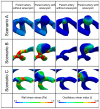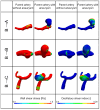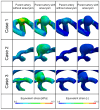Fluid-Structure Interaction Simulations of the Initiation Process of Cerebral Aneurysms
- PMID: 39451990
- PMCID: PMC11506655
- DOI: 10.3390/brainsci14100977
Fluid-Structure Interaction Simulations of the Initiation Process of Cerebral Aneurysms
Abstract
Background: Hemodynamics during the growth process of cerebral aneurysms are incompletely understood. We developed a novel fluid-structure interaction analysis method for the identification of relevant scenarios of aneurysm onset. Method: This method integrates both fluid dynamics and structural mechanics, as well as their mutual interaction, for a comprehensive analysis. Patients with a single unruptured cerebral aneurysm were included. Results: Overall, three scenarios were identified. In scenario A, wall shear stress (WSS) was low, and the oscillatory shear index (OSI) was high in large areas within the region of aneurysm onset (RAO). In scenario B, the quantities indicated a reversed behavior, where WSS was high and OSI was low. In the last scenario C, a behavior in-between was found, with scenarios A and B coexisting simultaneously in the RAO. Structural mechanics demonstrated a similar but independent trend. Further, we analyzed the change in hemodynamics between the onset and a fully developed aneurysm. While scenarios A and C remained unchanged during aneurysm growth, 47% of aneurysms in scenario B changed into scenario A and 20% into scenario C. Conclusions: In conclusion, these findings suggest that WSS and the OSI are reciprocally regulated, and both low and high WSS/OSI conditions can lead to aneurysm onset.
Keywords: cerebral aneurysm; fluid–structure interaction simulation; hemodynamics; initiation; structural mechanics.
Conflict of interest statement
Author Jozsef Nagy was employed by the company eulerian-solutions e.U., Authors Wolfgang Fenz, Stefan Thumfart were employed by the company RISC Software GmbH. All authors certify that they have no affiliations with or involvement in any organization or entity with any financial interest (such as honoraria; educational grants; participation in speakers’ bureaus; membership, employment, consultancies, stock ownership, or other equity interest; and expert testimony or patent-licensing arrangements) or non-financial interest (such as personal or professional relationships, affiliations, knowledge, or beliefs) in the subject matter or materials discussed in this manuscript. Generative AI was not used in the process of scientific writing.
Figures




References
-
- Detmer F.J., Chung B.J., Mut F., Pritz M., Slawski M., Hamzei-Sichani F., Kallmes D., Putman C., Jimenez C., Cebral J.R. Development of a statistical model for discrimination of rupture status in posterior communicating artery aneurysms. Acta Neurochir. 2018;160:1643–1652. doi: 10.1007/s00701-018-3595-8. - DOI - PMC - PubMed
LinkOut - more resources
Full Text Sources
Research Materials

